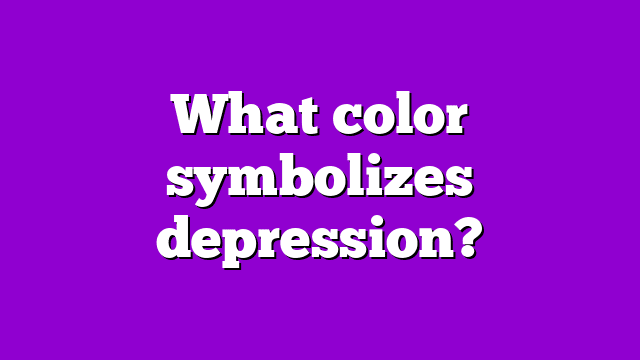Crystal Symbolism & Spirituality
What color symbolizes depression?
Depression is often associated with the color blue. It’s a color that conveys a sense of sadness, melancholy, and introspection. However, it’s important to note that depression is a complex emotional state and can manifest differently in different individuals. Some may not associate any specific color with depression or may have a different color that triggers their negative emotions.
On the other hand, when it comes to happiness, yellow is often regarded as the most cheerful color. Its bright and sunny appearance can evoke feelings of joy, warmth, and positivity. It’s a color that’s commonly used in marketing and advertising to promote happiness and optimism.
It’s worth mentioning that color psychology is not an exact science and can vary depending on cultural context, personal associations, and individual experiences. Nonetheless, here are some general perceptions and meanings associated with these colors:
- Blue: sadness, introspection, calmness, trust, and stability.
- Yellow: happiness, optimism, warmth, creativity, and energy.
Ultimately, it’s important to note that color is just one aspect of a vast and multifaceted spectrum of emotions, experiences, and perceptions. Understanding the symbolic meanings of colors can be a helpful tool in interpreting and expressing our emotions, but it’s essential to remember that everyone experiences and expresses their emotions differently.
Table Of Contents
- 1 The Emotions of Color: Understanding the Psychology Behind Depression and Happiness
- 2 Exploring the Symbolism of Blue: The Color Associated with Depression
- 3 Is Happiness Really Yellow? Debunking the Myth of the Happiest Color
- 4 How Color Therapy Can Benefit Those Struggling with Depression
- 5 The Healing Power of Green: Rediscovering Joy and Renewal
- 6 Orange, Pink, and Red: The Colors of Enthusiasm and Vibrancy
The Emotions of Color: Understanding the Psychology Behind Depression and Happiness
Color has a powerful influence on our emotions and can affect our mood, thoughts, and behaviors. The psychology of color has been studied extensively in the fields of art, design, and marketing, but it also has significant implications for mental health, particularly when it comes to depression and happiness. Understanding the emotional associations of different colors can help us better understand ourselves and those around us, and even inform therapeutic practices.
Exploring the Symbolism of Blue: The Color Associated with Depression
When we think of depression, the color that often comes to mind is blue. Symbolically, blue is associated with feelings of sadness, loneliness, and despair. Blue has a calming effect on the body and mind, which can be helpful for managing anxiety and stress, but prolonged exposure to blue can also exacerbate feelings of depression. Research has found that people with depression tend to prefer cooler colors like blue, while those without depression prefer warmer colors like red and orange.
Is Happiness Really Yellow? Debunking the Myth of the Happiest Color
Contrary to popular belief, there is no one color that universally represents happiness. While yellow is often cited as the happiest color, this association is largely culturally specific. In western cultures, yellow is associated with positivity, energy, and joy, while in some eastern cultures, it can signify mourning and betrayal. Additionally, individual experiences and personal preferences can greatly influence our emotional reactions to different colors. What brings one person joy might elicit anxiety or discomfort in another.
How Color Therapy Can Benefit Those Struggling with Depression
Color therapy, also known as chromotherapy, is an alternative healing practice that utilizes specific colors to balance and enhance the body’s energy centers, or chakras. Color therapists believe that specific colors can address physical, emotional, and psychological imbalances in the body, including depression. For example, blue light therapy has been shown to be an effective treatment for seasonal affective disorder (SAD) and other forms of depression. Green, yellow, and pink are colors that are often used to promote feelings of happiness, relaxation, and positivity.
The Healing Power of Green: Rediscovering Joy and Renewal
Green is a color that is associated with growth, renewal, and vitality. It is often used in nature-based therapies and other healing practices to promote feelings of grounding, balance, and harmony. For those struggling with depression, green can help facilitate a sense of renewal and connectedness to the natural world. One study found that viewing natural scenes that contain green elements can decrease feelings of anxiety and depression and increase positive mood.
Orange, Pink, and Red: The Colors of Enthusiasm and Vibrancy
While cooler colors like blue may be associated with sadness and depression, warmer colors like orange, pink, and red are often linked to enthusiasm and vibrancy. Orange is a color that is associated with creativity, passion, and motivation, while pink is often linked to love, compassion, and nurturing. Red is a color that can evoke feelings of energy, excitement, and power, although it can also be associated with aggression and stress.
In conclusion, color plays a significant role in our emotions and mental health. While certain colors may be associated with depression or happiness, individual experiences and cultural factors greatly influence our associations with color. Understanding the psychology of color can help us better understand ourselves and those around us, and may even inform therapeutic practices. Whether it’s through color therapy, nature-based therapies, or other healing practices, exploring the healing power of color can be a transformative and empowering experience.

